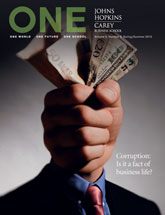
Sometimes the story involves an umbrella, but usually it’s a hat. As the urban legend goes, a man needs to protect himself from the sun during a tropical business trip. He buys a hat and dutifully submits the receipt with his expense report, but the accounting department won’t reimburse him for it. The man’s next expense report is a thing of beauty, every claim fully documented and exquisitely business-related. To this report, he clips a handwritten note saying only, “Find the hat.”
Though the story is apocryphal, the phenomenon is real. So-called “asset misappropriation,” such as fudging expense reports and pilfering office supplies, is endemic in the American workplace, accounting for 89 percent of all occupational fraud cases in 2008, according to the Association of Certified Fraud Examiners. Though estimates are hard to come by, ACFE’s data suggest that asset misappropriation could cost U.S. companies more than $50 billion annually. And, as the hat story suggests, even a worker who’s usually honest can sometimes justify skirting the rules and chiseling his employer. In fact, in a landmark 1983 study by sociologists Richard Hollinger and John Clark, fully 80 percent of workers surveyed admitted to “production deviance” such as misusing sick leave, and nearly one-third to having stolen money or merchandise on the job.
But is skirting the rules always a bad thing? Though it’s clear that most workplace fraud is costly and destructive, some organizational scientists have begun to suggest that there are times when small-scale employee pocket-lining could be relatively benign—and times when it could conceivably even benefit an employer.
The classic explanation for employee fraud comes from criminologist Donald R. Cressley, who in the 1940s declared three conditions necessary for fraud to occur. The first was pressure: Some outside force, such as gambling debts or medical bills, creates a need for extra money. The second was rationalization—a justification for stealing, such as the sense that the employee is underpaid. And the third was opportunity: lax oversight, or, in the words of Doonesbury’s Uncle Duke, “The pension fund was just sitting there.”
In a fraud investigator’s eyes, the only difference between a small fraud and a big one is opportunity. “The people who perpetrate expense account fraud, generally that’s the limit to what they can steal,” says James Ratley, ACFE president. “If they got a chance to steal a million dollars, they would.” Though your typical hat-hider might not think himself capable of grand larceny, Ratley’s field work tells him otherwise: “I’ve talked to enough fraud perpetrators—it’s like crack cocaine. Once you get started, you can’t stop.”
Pam Verrick, a director of the internal audit firm Protiviti, advocates a zero-tolerance policy for employers. “It doesn’t matter if it’s the small things or the large things,” she says. “You want to have a culture that embraces good behavior, and you want to know that your people are going to do the right thing.”
It’s true that some small-scale fraud is pretty audacious. One common scam involves meeting your spouse at the gas station in the family car, so you can fill it up at the same time as the company car—on the company’s dime. And relatively small charges can add up quickly: In 2008, Oversight Systems, an audit software company, gave a tongue-in-cheek “Fraudie” award to employees of one unnamed firm after the workers charged more than $100,000 in iTunes downloads to their corporate credit cards.
Bribe taking, too, starts small, experts say. Inexpensive gifts such as sports tickets or meals are frequently considered valid business courtesies, but some vendors seek to use them to gain leverage. Ralph Summerford, a fraud examiner in Birmingham, Alabama, recalls a family friend who came to him for advice after a vendor offered him a 12-gauge shotgun in exchange for information about competitors’ bids. “He said, ‘I didn’t know whether I could do it or I couldn’t do it,’” Summerford recalls. (Spoiler: He couldn’t.)
The young man’s uncertainty points to a major reason American businesses are vulnerable to employee fraud and corruption: They don’t always make their standards clear. Protiviti’s Verrick says that frequently even a company’s top managers can’t answer simple questions about its ethics policy, such as the value of gifts they’re allowed to accept. (A $25 or $50 limit is common but not universal.)
Business practices that protect companies from large-scale frauds
such as embezzlement can also nip small-time corruption in the bud.
For example,
splitting up the responsibility for accounts payable and accounts
receivable avoids a frequent opportunity for loss. The ACFE’s Ratley
recalls a Texas radio station that was shut down by its corporate
owners for unprofitability after the station’s ad salesmen
developed the habit of submitting fake orders for ads, pocketing their
commissions, and then claiming the ads had fallen through. With no
one checking a forgetful bookkeeper’s work, the unearned commissions
were never called back in.
Simple procedural changes such as switching from opaque trash bags to clear ones can make it more difficult for retail and restaurant employees to walk out the door with merchandise. And though technology has created more opportunities for employees to pilfer, it also offers new ways to catch them in the act. “Companies are starting to monitor eBay and Craigslist for company-issued equipment,” Verrick says.
But while auditors may see every pen-filcher as an embezzler in the making, some academics believe there are times when companies might as well tolerate, if not embrace, a certain amount of small-scale employee fraud. Sociologists Hollinger and Clark found that when employers place too much emphasis on preventing or discovering theft, they can create “an atmosphere of distrust and paranoia” that leads to lower morale and higher turnover. And low morale—specifically, a sense of being treated unfairly—is what the pair had discovered to be the key motivation for employee theft in the first place. Explains Arthur Brief, professor of business management at the University of Utah, “Stealing from the organization is often an attempt to get even with the organization, to establish equity: ‘They’re screwing me; I’m going to screw them.’” Given this outlook, it’s possible that a not-quite-kosher expense here and there could balance the scales in the employee’s mind, preventing worse misbehavior in the long run.
Michel Anteby, an assistant professor at Harvard Business School, recently studied a workplace where employees surreptitiously used company tools and materials to make personal items on company time—without necessarily harming their employer. In a French aeronautic plant he calls “Pierreville,” Anteby found that blacksmiths and other craftsmen made ashtrays, lamps, and other household objects, called “homers,” as gifts or for their own use. Though making homers was expressly forbidden by company policy, a different moral code was in place among the craftsmen who made them.
“The items were never sold,” says Anteby, who wrote about the plant in his book Moral Gray Zones (Princeton, 2008). “That was a huge taboo: You could do this to advance your craft or trade, but not to make a profit.” Workers used the side projects to refine their technical skills—a boon to their employer—and to earn respect and satisfaction not otherwise available in the plant, he says. Supervisors turned a blind eye to the practice because they “understand it’s something that allows employees to be who they want to be,” he adds.
Anteby has observed such “moral gray zones” among journalists, firefighters, and other types of workers: wherever employee groups have a strong collective identity. He mentions a U.S. pulp plant where one employee might offer to punch out another one’s time card, allowing the second worker to leave early without losing pay. “Those who got punched out were those who worked the best,” he says. “It was a way of recognizing their skill and ability.”
In general, tolerating such practices offers no direct benefit to a company, Anteby says, but in some instances, “it might be a useful tool. Where there is extremely long tenure, with no incentives or bonuses, someone could rely on this system to reward employees. And honestly, I think it might cost less.”
Naturally, neither Anteby nor any other credible business expert advocates employee theft of any scale, even the smallest. But that doesn’t mean that every act of small-time fraud is equally pernicious. Some may be relatively harmless, in context. And a few reveal a creativity that inspires if not imitation, then at least respect—a tip of the hat, if you will.



